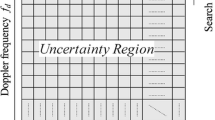Abstract
This paper studies the serial and parallel acquisition systems for the direct-sequence spread-spectrum(ds-ss) technique. The non coherent matched filter detector is employed. For the mean acquisition time, we give the exact expression, an approximate expression, an upper bound and a lower bound. An exhaustive comparison between the two systems is carried out. The aspects considered are essentially the pulse shape, the spreading gain, the non coherent addition of the information bits, the PN-sequence length and the detection threshold.
Résumé
Cet article étudie les deux méthodes d’acquisition de séquence pour la technique d’étalement de spectre à séquence directe : série et parallèle. Le détecteur non cohérent à filtre adapté est étudié. Pour le temps d’acquisition moyen, l’auteur donne l’expression exacte, une expression approximative, une borne supérieure et une borne inférieure. Une comparaison exhaustive entre les deux méthodes est effectuée. Les paramètres considérés sont essentiellement la forme de l’impulsion de base, le facteur d’étalement, l’addition non cohérente des bits d’information, la longueur de séquence pseudo aléatoire et le seuil de détection.
Similar content being viewed by others
RÉfÉrences
Simon (M.K.), et al., Spread spectrum communication,Vol. III. Computer Science Press (1985).
Polydoros (A.), Weber (C.L), A unified approach to serial search spread-spectrum code acquisition - part I: general theory,IEEE Trans. Com,32, N° 5, pp 542–549, (May, 1984).
Polydoros (A.), Weber (C.L), “A unified approach to serial search spread-spectrum code acquisition -part II: a matched filter receiver”,IEEE Trans. COM,32, N° 5, pp 550–560, (May, 1984).
Rappaport (S.S.), Grieco (D.M), Spread-spectrum signal acquisition: methods and technology,IEEE Commun. MAG.,22, pp 6–21, (June, 1984).
Su (Y.T.), Rapid code acquisition algorithms employing pn matched filters,IEEE Trans. COM. 36, n° 6, pp 724–733, (June, 1988).
Milstein (L.B.) et al., Rapid acquisition for direct sequence spread spectrum communication using parallel saw convolvers,IEEE Trans. COM. 33, n° 7, pp 593–600, (July, 1985).
Sourour (E.A.), Gupta (S.C.), Direct-sequence spread spectrum parallel acquisition in a fading mobile channel,IEEE Trans. COM. 38, n° 7, pp 992–998, (July, 1990).
Simon (M.K.), et al., Spread spectrum communication,Vol. II. Computer Science Press (1985).
Proakis (J.G.), Digital communication,McGraw-Hill Company (1989).
Polydoros (A.), Weber (C.L), Rapid acquisition techniques for direct-sequence spread spectrum systems using an analog detector,NTC’81 Conference Record, pp A7.1.1-7.1.5, (Novembre, 29- Decembre 3, 1981), New Orleans, LA.
Gradshteyn (I.S.), Ryzhik (I.M.) Table of integrals, series, and products,Academic Press, INC, (1985).
Author information
Authors and Affiliations
Corresponding author
Rights and permissions
About this article
Cite this article
Yuan-Wu, Y. Performance of the PN-sequence acquisition with the serial and parallel search strategies and the matched filter detector. Ann. Télécommun. 53, 320–333 (1998). https://doi.org/10.1007/BF02997689
Received:
Accepted:
Issue Date:
DOI: https://doi.org/10.1007/BF02997689
Key words
- Direct sequence spread spectrum
- Signal acquisition
- Pseudorandom sequence
- Matched filter
- Signal detection
- Correlation
- Statistical method




